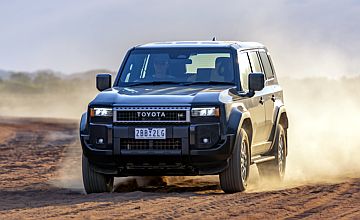OptionsCar reviews - Toyota - LandCruiser PradoToyota modelsOverviewWe like Far quieter and more spacious cabin, user-friendly HMI, refined driveline, polished dynamics and steering, impressive off-road ability Room for improvement Compromised seven-seat packaging, limited five-seat availability, minor wing mirror rustle, no round headlight treatment for Australia Fifth gen' LandCruiser Prado might just be the best family 4WD in the Aussie market21 Nov 2024 By MATT BROGAN Overview
THE all-new LandCruiser Prado is certainly more expensive than the model it replaces. Pricing starts from $72,500 plus on-road costs for the entry-level five-seat GX, making it close to $10,000 more than the kick-off price of the outgoing range.
That said, the difference between the old and the new is as clear as night and day…
Not much is carried over into the new-generation model apart from the nameplate; although the 1GD 2.8-litre turbo-diesel four-cylinder diesel engine producing 150kW of power and 500Nm of torque will be familiar to existing Prado owners.
The 250 Series Prado adds 48-volt mild-hybrid assistance into the deal and two more ratios in the automatic transmission (for a total of eight). And the changes don’t stop there.
Built on Toyota’s TNGA-F platform – shared with the V6 petrol-powered Lexus GX, Toyota LandCruiser 300 Series, Toyota Tundra and others – the new Prado adds electrically assisted steering, a powered park brake, increased towing capacity (now 3500kg), and significant advances in active safety and connectivity.
The towing capabilities of the new Prado are complemented by a tow/haul system that holds lower gears longer, gives better engine response during towing, and provides engine braking to help slow the vehicle.
Off-roading ability is enhanced by the permanent 4WD driveline, low-range gearing, centre differential, downhill assist control and multi-mode traction control, as well as 110 litres of fuel capacity.
Five- and seven-seat configurations are available, the more spacious cab drawing on a longer wheelbase than before and packed with features usually found far higher up the model walk.
These include a 12.3-inch touchscreen infotainment array paired with a 7.0-inch colour multi-information display, a panoramic view monitor, 10-speaker audio system with DAB+ digital radio, and four USB-C charging ports.
Every grade is equipped with cloud-based navigation, wireless Apple CarPlay, wireless Android Auto plus compatibility with Toyota Connected Services through the myToyota Connect smartphone app.
Further, all variants in the new Prado range are fitted with Toyota’s latest active safety technologies, including a pre-collision system, all-speed adaptive cruise control and lane trace assist.
Additional details of what is offered in each variant and full model pricing is available here.
Toyota offers the LandCruiser Prado with a five-year/unlimited-kilometre warranty, capped-price servicing, and six-month/10,000km service intervals.
Driving Impressions
Body-on-frame chassis arrangements are not typically the most obedient on-road partners. But the 250 Series LandCruiser Prado is a significant step above the pack, and lightyears ahead of its predecessor.
Coupled with more wheel travel than before, and lighter, electrically assisted steering, you could be forgiven for thinking the latest Prado might be a little ponderous. But that’s certainly not the case.
Body control is excellent in most cases, with the ability to recover from a high-speed swerve nothing short of outstanding. That said, we have some reservations about the softest Comfort setting of the adaptive dampers found in the range-topping Kakadu, which may be a little too spongey for the application.
The cushioned body mounts and underbody panelling found in the new LandCruiser Prado also help to achieve a quieter ride. In fact, we reckon it is almost as quiet as the Land Rover Defender, barring a hint of wind noise from the prominent door-mounted side mirrors.
Mechanical noise is equally well attenuated. Despite the engine being carried over from the 150 Series Prado (and others), we find an interesting change in pitch thanks to revised intake and exhaust manifolds that quietens the drama during heavy throttle applications.
Mated with a duteous and smooth-shifting transmission and there is very little NVH on which to remark. Put simply, the 250 Series LandCruiser Prado is far quieter and more refined than almost any competitor in its segment.
Acceleration is steady, but not brisk. If you need to race from the traffic lights then the Prado isn’t for you. It’s evident the 2.8-litre engine and eight-speed auto are geared instead to offer pulling power across the rev range, and for low-end crawling with a load on board.
The new transmission works incredibly well in this situation, communicating with the off-road assistants to lock up the torque converter and forge a way ahead. It is far more decisive than the six-speed Aisin unit it replaces while also providing a closer ratio set for improved fuel economy.
Prado’s other off-road ‘rabbit’ comes from its manoeuvrability. Despite having a wheelbase now shared with the LandCruiser 300 Series (2850mm, or +60mm), its short overhangs and quickened steering ratio means it’s a cinch to weave between trees and washaways (turning circle is listed at 12.0m).
Wheel placement is well communicated and visibility excellent, the high-resolution camera system filling any gaps as required via a button now conveniently relocated ahead of the gearshift.
For serious off-roaders, the Altitude version is likely to be a hit – even if the $92,700 + ORC price tag is a bit of a stretch. Rear and centre diff locks, an extended list of off-road modes, crawl control and a disconnecting front sway bar add to wheel travel that exceeds the outgoing model by up to 20 per cent.
Vital off-road geometry figures see the Prado offer a wading depth of 700mm and ground clearance of 210mm (221mm on VX, Altitude and Kakadu). The vehicle’s approach angle is listed at 31 degrees (32 degrees on VX, Altitude and Kakadu) and departure angle 17 degrees, but the break-over (or ramp-over) angle is not advised.
Surprisingly, and even on larger diameter 20-inch wheels, the Prado offers excellent bump absorption on corrugated unsealed roads – and with the tyres at road pressures. The double wishbone front and four-link solid rear arrangement assists the Prado’s excellent damping in providing straightforward control over fast-changing road surfaces.
The setup allows maximum tyre contact – and impressive feedback – even through mud and sand and is equally brilliant in low-speed crawling and in steep terrain.
Sure, we’d have loved a more aggressive tyre, but for 90 per cent of buyers the standard setup is close to ideal.
What isn’t ideal, however, is the compromised seven-seat arrangement of the GXL, VX and Kakadu variants. A “storage solution” resembling a flimsy Eski sits behind the third row of seats in an attempt to level the stowed height of the sixth and seventh seats for easier loading.
There is still a significant gap between the second- and third row of seats to contend with, and a maximum weight limit of 60kg on the lid of the storage box. We feel the arrangement is a compromise that won’t suit rough-and-tumble off-road buyers, who are instead left just two options: the entry-grade GX or expensive Altitude.
Storage capacity across the line-up sees five-seat variants offer 954-1895 litres and seven-seat variants 182-906-1829 litres. The 48-volt battery system (a 4.3Ah lithium-ion unit) is stored beneath the third row of seats and the full-size spare wheel beneath the floor.
Access to the cargo area is now via a top-hinged tailgate with an individual folding glass section, and not the side-hinged tailgate with external spare wheel as before.
With that said, the third row of seats is more user friendly than before. Bottle holders, USB-C charge points, HVAC outlets and increased head and knee room make the rearmost seats a better place to be. We even found them easier to clamber in and out of, in no small part because of the well-placed ‘foot plates’ outboard of the second row.
Further forward the Prado cabin is a far more intuitive place to be with sensibly positioned switchgear (no longer hidden from view in the lower dashboard) offering easier access to commonly used functions. The digital screens are set high and offer detailed, but not overwhelming, information pertinent to the driving environment.
Piano style buttons for the climate control are welcomed (no fiddly touchscreen here), as is a logical array of off-road controls set near the gear shift. Though we only spent a handful of hours in the new LandCruiser Prado, we were surprised by how quickly we could hit the right button without taking our eyes from the road. It’s really a very intuitive layout indeed.
The level of adjustability in the driver’s seat and steering column is well matched to the Prado’s lowered dashboard and window line, allowing the driver to sit comfortably low while still seeing out. If we were to be picky, the urethane steering wheel of the GX is not for us, the leather-wrapped offerings elsewhere in the range a far better choice in our opinion.
As we said at the outset, the fifth-gen LandCruiser Prado might just be the best family 4WD in the Aussie market. Sure, it’s pricier than before, but it’s also far better equipped, safer, more modern, and more economical than the model it replaces.
It is now a very strong and credible challenger to the inimitable Land Rover Defender while also being a vehicle that will wipe the floor with just about any other Large segment four-wheel drive you care to name.
 Read more19th of November 2024  New ordering system to ease Prado wait timesAs new sales record looms, Toyota aims to improve its ordering system for Prado buyers18th of November 2024  Prado possibilities centre on customer demandToyota engineer says ‘anything is possible’ if LandCruiser Prado customers demand itAll car reviews Alfa Romeo Alfa Romeo Abarth Abarth Alpine Alpine Alpina Alpina Audi Audi Aston Martin Aston Martin BMW BMW Bentley Bentley Chevrolet Chevrolet Chery Chery Citroen Citroen Chrysler Chrysler Dodge Dodge Cupra Cupra Ferrari Ferrari DS DS Ford Ford Fiat Fiat FPV FPV Foton Foton GWM GWM Great Wall Great Wall Holden Holden Haval Haval HSV HSV Honda Honda Hyundai Hyundai Hummer Hummer Isuzu Isuzu Infiniti Infiniti Jeep Jeep Jaguar Jaguar Lamborghini Lamborghini Kia Kia LDV LDV Land Rover Land Rover Lotus Lotus Lexus Lexus Maserati Maserati Mahindra Mahindra McLaren McLaren Mazda Mazda Mercedes-Benz Mercedes-Benz Mercedes-AMG Mercedes-AMG Mini Mini MG MG Nissan Nissan Mitsubishi Mitsubishi Peugeot Peugeot Opel Opel Proton Proton Porsche Porsche Renault Renault Ram Ram Rover Rover Rolls-Royce Rolls-Royce Skoda Skoda Saab Saab SsangYong SsangYong Smart Smart Suzuki Suzuki Subaru Subaru Toyota Toyota Tesla Tesla Volvo Volvo |
OptionsClick to share
|
















Facebook Twitter Instagram